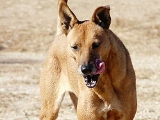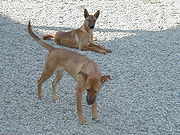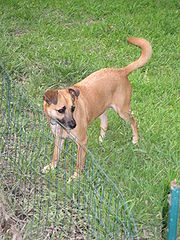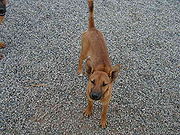
Carolina Dog
Encyclopedia
The Carolina Dog, or American Dingo, is a landrace
Landrace
A landrace is a local variety of a domesticated animal or plant species which has developed largely by natural processes, by adaptation to the natural and cultural environment in which it lives. It differs from a formal breed which has been bred deliberately to conform to a particular standard...
or naturally selected
Natural selection
Natural selection is the nonrandom process by which biologic traits become either more or less common in a population as a function of differential reproduction of their bearers. It is a key mechanism of evolution....
type of dog which was discovered living as a wild dog
Wild dog
Wild dog is a term broadly applied to canines which are either not domesticated or not owned. It may also refer to:* Feral dogs, domestic dogs living as wild animals....
or free roaming dog by Dr Lehr.J. Brisbin. CDs are now bred and kept in captive collections or packs. They were discovered during the 1970s living in isolated stretches of longleaf pine
Longleaf Pine
Pinus palustris, commonly known as the Longleaf Pine, is a pine native to the southeastern United States, found along the coastal plain from eastern Texas to southeast Virginia extending into northern and central Florida....
s and cypress
Taxodium
Taxodium is a genus of one to three species of extremely flood-tolerant conifers in the cypress family, Cupressaceae...
swamp
Swamp
A swamp is a wetland with some flooding of large areas of land by shallow bodies of water. A swamp generally has a large number of hammocks, or dry-land protrusions, covered by aquatic vegetation, or vegetation that tolerates periodical inundation. The two main types of swamp are "true" or swamp...
s in the Southeastern United States
Southeastern United States
The Southeastern United States, colloquially referred to as the Southeast, is the eastern portion of the Southern United States. It is one of the most populous regions in the United States of America....
. Carolina Dogs are of medium size, with a fawn
Fawn (colour)
Fawn is a light yellowish brown colour that is usually used in reference to a dog's coat colour.The first recorded use of fawn as a colour name in English was in 1789.-Fawn in animal breeds:Dog Breeds...
coat and frequently a melanistic mask
Melanistic mask
A melanistic mask is a dog coat pattern that gives the appearance of a mask on the dog's face. The hairs on the muzzle, and sometimes entire face or ears, are colored by eumelanin instead of pheomelanin pigment. Eumelanin is typically black, but may instead be brown, dark gray, or light gray-brown...
.
Discovery

Ecology
Ecology is the scientific study of the relations that living organisms have with respect to each other and their natural environment. Variables of interest to ecologists include the composition, distribution, amount , number, and changing states of organisms within and among ecosystems...
at the University of Georgia
University of Georgia
The University of Georgia is a public research university located in Athens, Georgia, United States. Founded in 1785, it is the oldest and largest of the state's institutions of higher learning and is one of multiple schools to claim the title of the oldest public university in the United States...
's Savannah River Ecology Lab
Savannah River Ecology Laboratory
The Savannah River Ecology Laboratory is a research unit of the University of Georgia, located at the U.S. Department of Energy's Savannah River Site in Aiken, South Carolina. SREL is supported by federal, state, industry and foundation funding.Since the laboratory's founding in 1951 by Dr...
, first came across a Carolina Dog while working at the Savannah River
Savannah River
The Savannah River is a major river in the southeastern United States, forming most of the border between the states of South Carolina and Georgia. Two tributaries of the Savannah, the Tugaloo River and the Chattooga River, form the northernmost part of the border...
site. Horace, a stray white dog with brown markings, was wandering the site's boundary when he caught Brisbin’s attention. Brisbin, who had seen many rural dogs chained to the back of porches and doghouse
Doghouse
A doghouse, known in British English as a kennel, is a small shed commonly built in the shape of a little house intended for a dog. It is a structure in which a dog is kept or can run into for shelter from the elements.-Architecture:...
s, assumed this was just a normal stray. Many of these dogs roamed the woods and would turn up in humane traps, and Brisbin began to wonder how many more of these were in the wild. On a hunch, he went to the pound and was surprised by the resemblance the dog had to dingo
Dingo
The Australian Dingo or Warrigal is a free-roaming wild dog unique to the continent of Australia, mainly found in the outback. Its original ancestors are thought to have arrived with humans from southeast Asia thousands of years ago, when dogs were still relatively undomesticated and closer to...
es.
Physical

Native Americans in the United States
Native Americans in the United States are the indigenous peoples in North America within the boundaries of the present-day continental United States, parts of Alaska, and the island state of Hawaii. They are composed of numerous, distinct tribes, states, and ethnic groups, many of which survive as...
depict dogs that have physical traits similar to those of Carolina Dogs. Carolina Dogs also have a ginger-colored coat that is found on other wild dogs, including Australian Dingoes and Korea’s native dog, the Jindo
Korea Jindo Dog
The Korean Jindo Dog is a breed of hunting dog known to have originated on Jindo Island in South Korea. Brought to the US with Korean immigrants, it is celebrated in its native land for its fierce loyalty and brave nature...
.
Also, fossil
Fossil
Fossils are the preserved remains or traces of animals , plants, and other organisms from the remote past...
s of the dogs of Native Americans exhibit similar bone structures to Carolina Dogs. Brisbin found a resemblance between 2,000-year-old skulls and those of the Carolina Dogs, but concluded that there was too large a difference to prove any connection. Along with this, DNA testing has pointed to a link.
Height: 17-24 inches (45–61 cm.)
Weight: 30-65
pounds (15–20 kg.)
Behavior

Female dogs had three estrus cycles
Estrous cycle
The estrous cycle comprises the recurring physiologic changes that are induced by reproductive hormones in most mammalian placental females. Estrous cycles start after puberty in sexually mature females and are interrupted by anestrous phases or pregnancies...
in quick succession, which settled into seasonal reproductive cycles when there was an abundance of puppies. Brisbin noted that this was most likely to ensure quick breeding before diseases, like heartworm
Heartworm
Heartworm is a parasitic roundworm that is spread from host to host through the bites of mosquitoes. The heartworm is a type of filaria, a small thread-like worm. The definitive host is the dog but it can also infect cats, wolves, coyotes, foxes and other animals, such as ferrets, sea lions and...
, take their toll. Some pregnant dogs also dug dens
Dens
Dens may refer to:* Den *Dens , also known as odontoid process or odontoid peg*Tooth...
in which to give birth. After they gave birth or while pregnant, the dog would carefully push sand with her snout to cover her excrement. The dogs also dug “snout pits”, or hundreds of tiny holes in the dirt that perfectly fit their muzzles during this time. More female dogs dug them than males.
In the wild, Carolina dogs lived in swampy, sparsely settled land instead of the highly populated areas stray dogs commonly occupied. When hunting, Carolina Dogs used an effective pack formation. They hunted snake
Snake
Snakes are elongate, legless, carnivorous reptiles of the suborder Serpentes that can be distinguished from legless lizards by their lack of eyelids and external ears. Like all squamates, snakes are ectothermic, amniote vertebrates covered in overlapping scales...
s using a whip
Whip
A whip is a tool traditionally used by humans to exert control over animals or other people, through pain compliance or fear of pain, although in some activities whips can be used without use of pain, such as an additional pressure aid in dressage...
-like motion, and predated on small and medium-sized mammals such as raccoon
Raccoon
Procyon is a genus of nocturnal mammals, comprising three species commonly known as raccoons, in the family Procyonidae. The most familiar species, the common raccoon , is often known simply as "the" raccoon, as the two other raccoon species in the genus are native only to the tropics and are...
s.
DNA testing
The preliminary DNA testingGenetic fingerprinting
DNA profiling is a technique employed by forensic scientists to assist in the identification of individuals by their respective DNA profiles. DNA profiles are encrypted sets of numbers that reflect a person's DNA makeup, which can also be used as the person's identifier...
may provide a link between primitive dogs and Carolina Dogs. Brisbin stated, “We grabbed them out of the woods based on what they look like, and if they were just dogs their DNA patterns should be well distributed throughout the canine family tree. But they aren't. They're all at the base of the tree, where you would find very primitive dogs.” This wasn’t conclusive, but it did spark interest into more extensive DNA testing.
Breed recognition and domestication

American Rare Breed Association
The American Rare Breed Association or ARBA is a national dog association of the United States, based in Cheltenham, Prince George's County, Maryland. The club was formed to register, show, educate and promote the breeding of uncommon dog breeds...
and the United Kennel Club
United Kennel Club
The United Kennel Club is the second oldest all-breed registry of purebred dog pedigrees in the United States and the second largest in the world. According to the website, the club records 250,000 registrations annually. The UKC is not part of the International Canine Organisation, Fédération...
.
ARBA includes the breed in its "Spitz and Primitive Group", which includes primitives such as the dingo
Dingo
The Australian Dingo or Warrigal is a free-roaming wild dog unique to the continent of Australia, mainly found in the outback. Its original ancestors are thought to have arrived with humans from southeast Asia thousands of years ago, when dogs were still relatively undomesticated and closer to...
and Canaan Dog
Canaan Dog
The Canaan dog is a Canaanite breed of dog which may have existed in the eastern Mediterranean seaboard for millennia, as referenced in ancient sculptures.-Appearance:...
. The UKC has classified them as a pariah dog
Pariah dog
The term pariah dog originally referred to Chinese/Indian feral dogs of a particular type, but it is now used by the United Kennel Club to refer to a purebred dog category.- Feral dogs of India :...
, a class which includes other primitive breeds such as the Basenji
Basenji
The Basenji is a breed of hunting dog that was bred from stock originating in central Africa. Most of the major kennel clubs in the English-speaking world place the breed in the Hound Group; more specifically, it may be classified as belonging to the sighthound type...
of Africa and the Thai Ridgeback
Thai Ridgeback
The Thai Ridgeback is an ancient breed of dog. The breed was formerly unknown outside of Thailand, but is gaining notice in the Western world. The Thai Ridgeback is one of only three breeds that has a ridge of hair that runs along its back in the opposite direction to the rest of the coat...
.
The word pariah is derived from a Tamil word first used in English in 1613, to refer to the lowest level of the traditional Indian caste system
Caste system in India
The Indian caste system is a system of social stratification and social restriction in India in which communities are defined by thousands of endogamous hereditary groups called Jātis....
; in English, it is used to mean "a social outcast". The Indian feral dog was considered an outcast as well. The term "pariah" when referring to feral or wild dogs of the Indian feral dog type is sometimes replaced with primitive
Primitive
Primitive may refer to:* Anarcho-primitivism, an anarchist critique of the origins and progress of civilization* Primitive culture, one that lacks major signs of economic development or modernity...
, in the sense of "relating to an earliest or original stage or state" or "being little evolved from an early ancestral type".
It is assumed that dogs placed in "pariah" or "primitive" groups are of an older type than other modern dog breeds. Future genetic testing may show the actual heredity of these breeds or types.
See also
- DingoDingoThe Australian Dingo or Warrigal is a free-roaming wild dog unique to the continent of Australia, mainly found in the outback. Its original ancestors are thought to have arrived with humans from southeast Asia thousands of years ago, when dogs were still relatively undomesticated and closer to...
- New Guinea Singing DogNew Guinea Singing DogThe New Guinea Singing Dog is a wild dog once found throughout New Guinea. New Guinea Singing Dogs are named for their unique howl....
- Indian pariah dogIndian pariah dogThe Indian pariah dog is a purebred dog category of pariah dog.- Traits :The aboriginal breed of the Indian sub-continent is called the Indian Pariah Dog, Indian Native Dog and is nowadays referred to as the INDog by experts and enthusiasts...
- Rare breed (dog)Rare breed (dog)Rare breed is any breed of dog that is small in number. Since dogs have greater genetic variability than other domesticated animals the number of possible breeds is vast...
- NureongiNureongiThe Nureongi also spelled Noo-rung-yee is a yellowish dog landrace from Korea. It is most often used as a livestock dog, raised for its meat and not commonly kept as a pet.-Terminology:This dog has no formal name...
- Subspecies of Canis lupusSubspecies of Canis lupusCanis lupus has 39 subspecies currently described, including two subspecies of domestic dog, Canis lupus dingo and Canis lupus familiaris, and many subspecies of wolf throughout the Northern hemisphere...

